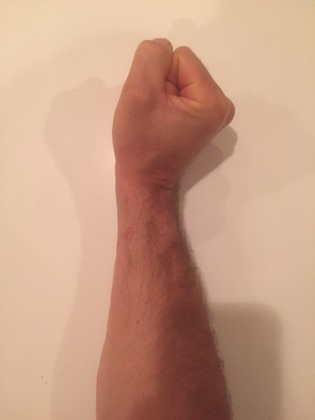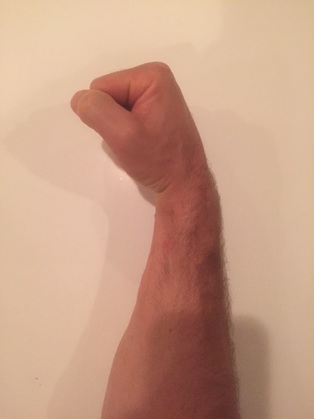|
Although playing tennis can result in tennis elbow, most cases of tennis elbow, also known as lateral epicondylitis, are actually due to overuse when working with the hands. A tendon is the tissue that attaches muscle to bone. The suffix "itis" means inflammation, and while acute overuse injury can cause inflammation, the typical case of tennis elbow is more chronic, due to repeated overuse, and results in degeneration of the tissue. This situation is more appropriately called "tendinosis." The pointy bone that sticks out on the outside of the elbow is called the lateral epicondyle. This is the common origin of the wrist extensor muscles which cross the elbow and then cross the wrist. It is this tendon that is injured with tennis elbow. So, when attempting to grip something firmly, the wrist extensor muscles (that attach to the outside of the elbow called the lateral epicondyle) contract firmly. This is fine. Now when elbow range of motion is added simultaneously, the wrist extensor muscles experience shearing, or variation in the force they experience, while the elbow moves. Additional irritation like a short rapid wrist flexion force can sometimes occur. This combination of forces can create trauma to the extensor muscle group at its insertion point on the lateral elbow (lateral epicondyle). A perfect example of the above scenario is when the tennis ball makes contact with the racket during a backhand swing, hence the name tennis elbow. A more common situation in my practice would be swinging a hammer all day, scraping paint, or pulling weeds. Basically power grip with the hand superimposed on simultaneous wrist and elbow range of motion. Acutely, micro-tears can occur in the muscle origin on the outside of the elbow (lateral epicondyle). This can create pain and inflammation. When allowed to rest and recover, the issue resolves. However when the overuse occurs repeatedly, and the micro-tears are not allowed to fully resolve prior to additional trauma, the condition can become chronic. The normal tendon tissue (a tendon is the tissue that attaches muscle to bone) breaks down, and the tissue becomes disorganized and weak (tendinosis).
Lets talk about treatment. It is important to know that proper non-operative treatment will cure 90% of people. Unfortunately, especially in chronic cases, it can take months to resolve.
google-site-verification: googlee8ce9aaf537c901b.html
2 Comments
4/8/2021 03:30:39 am
Yes tennis elbow is a serious issue. The scenarios you have described are very accurate. The treatment points are well covered too and I fully agree that the person should stop doing that activity causing tennis elbow but i don't like the idea of steroid avoid this if you can. Thanks for the lovely share.
Reply
4/13/2021 07:30:14 pm
Agreed- steroid injection is not ideally used as first-line treatment. I think it is reasonable to consider it in an attempt to prevent/delay surgery in resistant cases though.
Reply
Your comment will be posted after it is approved.
Leave a Reply. |
Dr. GorczynskiOrthopedic Surgeon focused on the entire patient, not just a single joint. Categories
All
|



 RSS Feed
RSS Feed